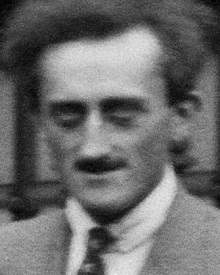Francis Perrin (physicist) facts for kids
Francis Perrin (born August 17, 1901 – died July 4, 1992) was a French physicist. He was the son of Jean Perrin, who also won a Nobel Prize in physics.
A Brilliant Physicist
Francis Perrin was born in Paris, France. He studied at a famous school called École Normale Supérieure in Paris. In 1928, he earned his doctorate degree in math and science. His main work was about something called Brownian motion, which is how tiny particles move randomly in a fluid. After that, he became a teacher at the Collège de France.
In 1933, Francis Perrin studied tiny particles called neutrinos. He thought that these particles must have no mass, or at least be much, much lighter than an electron. Later, he worked on how uranium splits apart, a process called fission. In 1939, with Frédéric Joliot and his team, he showed that it was possible to create a nuclear chain reaction. This discovery was very important for producing nuclear energy.
From 1946 to 1972, he was a professor at the Collège de France. He taught about atomic and molecular physics. He also served as the French high-commissioner for atomic energy from 1951 to 1970. In 1972, he made an amazing discovery: he found the Oklo natural reactor. This was a place in nature where nuclear reactions happened all by themselves, billions of years ago!
Perrin strongly supported the idea of a European center for nuclear research. He signed an agreement for France to help create CERN in Geneva in 1952. CERN is now one of the world's largest and most respected centers for scientific research. He was chosen as the vice-president of CERN's first council. He remained France's representative on the CERN Council until 1972.
Leading Nuclear Energy
In 1951, Francis Perrin became the High-Commissioner of the Commissariat à l'énergie atomique (CEA), which is France's Atomic Energy Commission. He took over from Frédéric Joliot-Curie, who had been removed because he didn't agree with military research.
Francis Perrin joined a group of about a dozen influential people. This group included politicians, military officers, and scientists. They worked together to push for a strong nuclear research program in France. Their goal was for France to develop nuclear weapons without outside control. Secret departments were set up within the CEA starting in 1954 to make this happen.
General Charles de Gaulle learned about this work when he was out of power (1953-1958). When de Gaulle returned to power in 1958, the work was so far along that the date for France's first nuclear test was already set for 1960.
In 1986, Francis Perrin publicly shared that in 1949, scientists from Israel were invited to the Saclay Nuclear Research Centre in France. This led to a joint effort where French and Israeli scientists shared knowledge, especially from the Manhattan Project. The Manhattan Project was a secret research project during World War II that developed the first atomic bombs.
Personal Life
Francis Perrin married Colette Auger, who was the sister of another physicist named Pierre Victor Auger. After he left his role at the French atomic energy commission, Francis Perrin became the president of the Union des Athées (Union of Atheists). In Spanish: Francis Perrin para niños
In Spanish: Francis Perrin para niños



